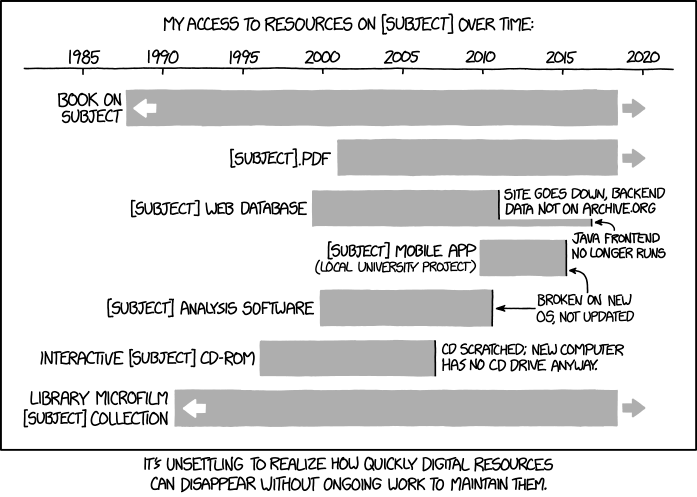Today's excellent (as usual) xkcd cartoon by Randall Munroe reminds us of the ephemerality of digital information.
Once again, this being a topic I have raised over and over in this blog, I'd like to mention that the definitive work on this topic is
Jeff Rothenberg, "Ensuring the Longevity of Digital Documents", Scientific American, vol. 272, no. 1, January 1995 .A digital copy of Rothenberg's article can, at least at the moment, be found at
https://www.clir.org/pubs/archives/ensuring.pdf .It's well worth reading. And appropriately terrifying, given the season.
It's not just the digital media itself that has a (sometimes remarkably short) lifespan, but also the technology - both hardware and software - to read the media, and even the specifications that describe the format and encoding of the media. I've seen a vase from ancient Greece inscribed with art and symbols that are perfectly legible millennia later. I've been up close to a first edition of a book written by Galileo in the early 18th century. We can still read the letters John Adams and his wife Abagail wrote to one another during the time of the American war of independence. I have CD-ROMs that are just a few years old which are no longer usable. And trying to read the eight-inch floppy disks for the CP/M file system that have the text of my master's thesis in WordStar format? Good luck. (The thirty-four year old hardbound version on acid-free paper is completely legible.)
The only way to insure the longevity of digital information is to continuously refresh it onto new media using current technology. This becomes less and less practical as the amount of digital information continues to grow an a rate that can only be described as alarming.


1 comment:
Recently came across this paper by Long Tien Nguyen and Alan Kay which is in the solution space of approaches: http://www.vpri.org/pdf/tr2015004_cuneiform.pdf
Post a Comment